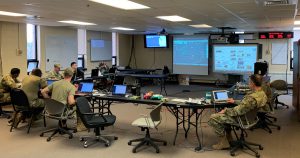Fort Drum’s Mission Training Complex team supports Maryland Army NG with distributed training due to COVID-19
By Michael Strasser, Fort Drum Garrison Public Affairs
FORT DRUM, N.Y. — Soldiers from Maryland Army National Guard’s 58th Expeditionary Military Intelligence Brigade were planning to train at Fort Drum this week in preparation for their deployment to the Central Command area of responsibility. Then, the Coronavirus (COVID-19) pandemic changed everything.
Rather than Soldiers risking exposure to the virus or not being able to return home due to travel restrictions, their commander decided against troop movement to the northern New York installation.
The five-day training exercise, however, is still a go.
A team from Fort Drum’s Townsend Mission Training Complex (TMTC) spent months preparing the pre-mobilization staff exercise with elaborate training scenarios to meet the unit’s unique asset management mission.
When the 58th EMIB Soldiers deploy as Task Force Chesapeake, they will be responsible for managing assigned theater intelligence surveillance and reconnaissance assets in support of Operation Resolute Support.
Notified that the roughly 35 Soldiers would not be arriving at Fort Drum, the TMTC team figured out a way to deliver the training to the 58th EMIB headquarters in Towson, Maryland.
Jeffrey East and Tom Hammond, TMTC training integrators, served as the lead planner and lead developer, respectively, for the exercise.
“They didn’t want to lose out on the training, so basically, in 24 hours we arranged to get them distributed training that meets their intent,” East said. “It basically follows the same battle rhythm they would gotten if they were here at Fort Drum.”
 Hammond said that the virtual exercise meets the commander’s training intent by giving the Soldiers the ability to look at the same assets they would have in theater and to make decisions based on a series of events and assets.
Hammond said that the virtual exercise meets the commander’s training intent by giving the Soldiers the ability to look at the same assets they would have in theater and to make decisions based on a series of events and assets.
“I would say it was a happy accident that I had all of their assets developed into an environment where we could actually do this as distributed training,” he said. “Basically, they are down at home station working off their NIPR (non-classified) computers and we are working on ours, providing an equivalent level of injects and scenarios that they would experience in deployment.”
In one battle drill on March 17, the training scenario involved troops making contact with enemy forces, while an aircraft experienced maintenance issues and was forced to land.
“So, now they have to decide if they shift other assets from their current missions to support this one, or take another course of action,” Hammond said. “Right now our team here is monitoring this and providing them a full immersive story as if they were in theater right now. We feed them the information and they process and make decisions based on that.”
Hammond previously worked on the 10th Combat Aviation Brigade’s training exercise last summer before the Soldiers’ upcoming deployment, and he was able to use that to augment what the 58th is currently experiencing.
“Using real-world data from the 10th CAB for this exercise, they would be able to get a more immersive, real-world view,” he said.
Master Sgt. Fred Rudder, 58th EMIB operations noncommissioned officer, said that they worked closely with Fort Drum’s TMTC staff to craft a staff exercise that would closely replicate anticipated operations they may encounter on deployment.
“With continued support and expertise from the TMTC staff throughout the home station exercise, the 58th EMIB was able to virtually recreate most Mission Training Center products and functions to achieve a viable and worthwhile staff exercise,” he said.
At the TMTC, Hammond said that they are used to training getting postponed a day or two because of adverse weather, but the COVID-19 pandemic is a whole new situation.
“This unit was very particular about getting this training in, and we were more than happy to give them that with our guys on the ground,” he said.

